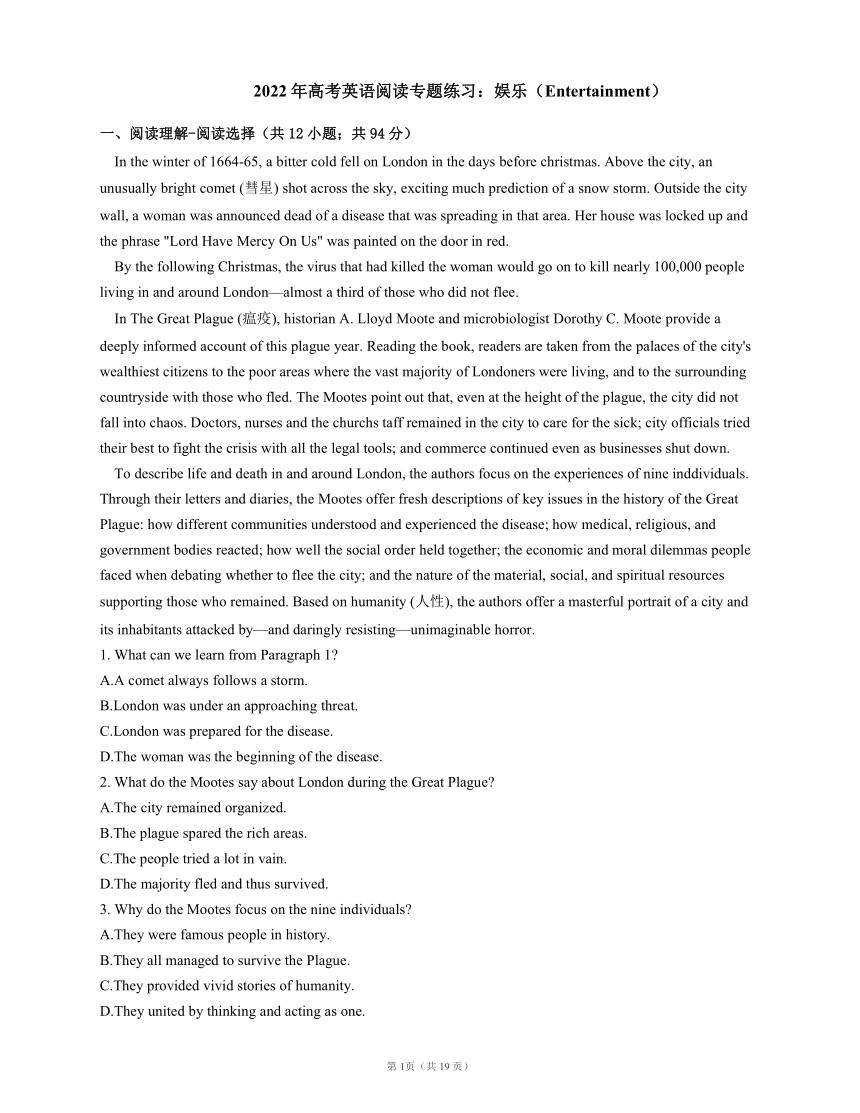
2022年高考英语阅读专题练习:娱乐(Entertainment) 一、阅读理解-阅读选择(共12小题;共94分) In the winter of 1664-65, a bitter cold fell on London in the days before christmas. Above the city, an unusually bright comet (彗星) shot across the sky, exciting much prediction of a snow storm. Outside the city wall, a woman was announced dead of a disease that was spreading in that area. Her house was locked up and the phrase "Lord Have Mercy On Us" was painted on the door in red. By the following Christmas, the virus that had killed the woman would go on to kill nearly 100,000 people living in and around London—almost a third of those who did not flee. In The Great Plague (瘟疫), historian A. Lloyd Moote and microbiologist Dorothy C. Moote provide a deeply informed account of this plague year. Reading the book, readers are taken from the palaces of the city's wealthiest citizens to the poor areas where the vast majority of Londoners were living, and to the surrounding countryside with those who fled. The Mootes point out that, even at the height of the plague, the city did not fall into chaos. Doctors, nurses and the churchs taff remained in the city to care for the sick; city officials tried their best to fight the crisis with all the legal tools; and commerce continued even as businesses shut down. To describe life and death in and around London, the authors focus on the experiences of nine inddividuals. Through their letters and diaries, the Mootes offer fresh descriptions of key issues in the history of the Great Plague: how different communities understood and experienced the disease; how medical, religious, and government bodies reacted; how well the social order held together; the economic and moral dilemmas people faced when debating whether to flee the city; and the nature of the material, social, and spiritual resources supporting those who remained. Based on humanity (人性), the authors offer a masterful portrait of a city and its inhabitants attacked by—and daringly resisting—unimaginable horror. 1. What can we learn from Paragraph 1 A.A comet always follows a storm. B.London was under an approaching threat. C.London was prepared for the disease. D.The woman was the beginning of the disease. 2. What do the Mootes say about London during the Great Plague A.The city remained organized. B.The plague spared the rich areas. C.The people tried a lot in vain. D.The majority fled and thus survived. 3. Why do the Mootes focus on the nine individuals A.They were famous people in history. B.They all managed to survive the Plague. C.They provided vivid stories of humanity. D.They united by thinking and acting as one. 4. What's the purpose of this text A.To introduce a new book. B.To correct a misunderstanding. C.To report a new research. D.To show respect to the authors. Attend the Next Forum! For the last twelve years CPSB has had the pleasure of hosting learning event we call a Forum. We started offering programs in Sarasota in February in 1991 a ... ...
~~ 您好,已阅读到文档的结尾了 ~~

